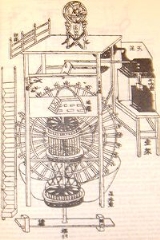
Su Song
Encyclopedia
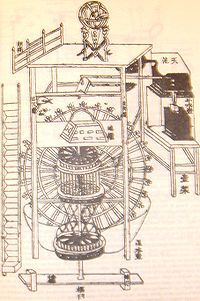
Polymath
A polymath is a person whose expertise spans a significant number of different subject areas. In less formal terms, a polymath may simply be someone who is very knowledgeable...
who specialized himself as a statesman, astronomer
Chinese astronomy
Astronomy in China has a very long history, with historians considering that "they [the Chinese] were the most persistent and accurate observers of celestial phenomena anywhere in the world before the Arabs."...
, cartographer, horologist
Horology
Horology is the art or science of measuring time. Clocks, watches, clockwork, sundials, clepsydras, timers, time recorders and marine chronometers are all examples of instruments used to measure time.People interested in horology are called horologists...
, pharmacologist
Traditional Chinese medicine
Traditional Chinese Medicine refers to a broad range of medicine practices sharing common theoretical concepts which have been developed in China and are based on a tradition of more than 2,000 years, including various forms of herbal medicine, acupuncture, massage , exercise , and dietary therapy...
, mineralogist
Mineralogy
Mineralogy is the study of chemistry, crystal structure, and physical properties of minerals. Specific studies within mineralogy include the processes of mineral origin and formation, classification of minerals, their geographical distribution, as well as their utilization.-History:Early writing...
, zoologist
Zoology
Zoology |zoölogy]]), is the branch of biology that relates to the animal kingdom, including the structure, embryology, evolution, classification, habits, and distribution of all animals, both living and extinct...
, botanist
Botany
Botany, plant science, or plant biology is a branch of biology that involves the scientific study of plant life. Traditionally, botany also included the study of fungi, algae and viruses...
, mechanical
Mechanics
Mechanics is the branch of physics concerned with the behavior of physical bodies when subjected to forces or displacements, and the subsequent effects of the bodies on their environment....
and architectural engineer
Chinese architecture
Chinese architecture refers to a style of architecture that has taken shape in East Asia over many centuries. The structural principles of Chinese architecture have remained largely unchanged, the main changes being only the decorative details...
, poet
Chinese poetry
Chinese poetry is poetry written, spoken, or chanted in the Chinese language, which includes various versions of Chinese language, including Classical Chinese, Standard Chinese, Mandarin Chinese, Cantonese, Yue Chinese, as well as many other historical and vernacular varieties of the Chinese language...
, antiquarian
Antiquarian
An antiquarian or antiquary is an aficionado or student of antiquities or things of the past. More specifically, the term is used for those who study history with particular attention to ancient objects of art or science, archaeological and historic sites, or historic archives and manuscripts...
, and ambassador
Foreign relations of Imperial China
Imperial China had a long tradition of foreign relations. From the Qin Dynasty until the Qing Dynasty, the Culture of China had an impact upon neighboring and distant countries, while gradually being transformed by outside influences as well....
of the Song Dynasty
Song Dynasty
The Song Dynasty was a ruling dynasty in China between 960 and 1279; it succeeded the Five Dynasties and Ten Kingdoms Period, and was followed by the Yuan Dynasty. It was the first government in world history to issue banknotes or paper money, and the first Chinese government to establish a...
(960–1279).
Su Song was the engineer of a water-driven
Hydraulics
Hydraulics is a topic in applied science and engineering dealing with the mechanical properties of liquids. Fluid mechanics provides the theoretical foundation for hydraulics, which focuses on the engineering uses of fluid properties. In fluid power, hydraulics is used for the generation, control,...
astronomical
Astronomical clock
An astronomical clock is a clock with special mechanisms and dials to display astronomical information, such as the relative positions of the sun, moon, zodiacal constellations, and sometimes major planets.-Definition:...
clock tower
Clock tower
A clock tower is a tower specifically built with one or more clock faces. Clock towers can be either freestanding or part of a church or municipal building such as a town hall. Some clock towers are not true clock towers having had their clock faces added to an already existing building...
in medieval Kaifeng
Kaifeng
Kaifeng , known previously by several names , is a prefecture-level city in east-central Henan province, Central China. Nearly 5 million people live in the metropolitan area...
, which employed the use of an early escapement
Escapement
In mechanical watches and clocks, an escapement is a device that transfers energy to the timekeeping element and enables counting the number of oscillations of the timekeeping element...
mechanism. The escapement mechanism of Su's clock tower had previously been invented by Buddhist monk
Monk
A monk is a person who practices religious asceticism, living either alone or with any number of monks, while always maintaining some degree of physical separation from those not sharing the same purpose...
Yi Xing
Yi Xing
Yi Xing , born Zhang Sui , was a Chinese astronomer, mathematician, mechanical engineer,and Buddhist monk of the Tang Dynasty...
and government official Liang Lingzan in 725 AD to operate a water-powered armillary sphere
Armillary sphere
An armillary sphere is a model of objects in the sky , consisting of a spherical framework of rings, centred on Earth, that represent lines of celestial longitude and latitude and other astronomically important features such as the ecliptic...
, although Su's armillary sphere was the first to be provided with a mechanical clock drive. Su's clock tower also featured the oldest known endless power-transmitting chain drive
Chain drive
Chain drive is a way of transmitting mechanical power from one place to another. It is often used to convey power to the wheels of a vehicle, particularly bicycles and motorcycles...
, called the tian ti (天梯), or "celestial ladder", as depicted in his horological treatise. The clock tower had 133 different clock jacks to indicate and sound the hours
Striking clock
A striking clock is a clock that sounds the hours audibly on a bell or gong. In 12 hour striking, used most commonly in striking clocks today, the clock strikes once at 1 AM, twice at 2 AM, continuing in this way up to twelve times at 12 noon, then starts over, striking once at 1 PM, twice at 2...
. Su Song's treatise about the clock tower, Xinyi Xiangfayao (新 儀 . 象 法 要), has survived since its written form in 1092 and official printed publication in 1094. The book has been analyzed by many historians, such as Joseph Needham
Joseph Needham
Noel Joseph Terence Montgomery Needham, CH, FRS, FBA , also known as Li Yuese , was a British scientist, historian and sinologist known for his scientific research and writing on the history of Chinese science. He was elected a fellow of the Royal Society in 1941, and as a fellow of the British...
. However, the clock itself was dismantled by the invading Jurchen army in AD 1127, and although attempts were made to reassemble the clock tower, it was never successfully reinstated. Although the Xinyi Xiangfayao was his best known treatise, the polymath had other works compiled as well. He completed a large celestial atlas of several star maps, several terrestrial
Earth
Earth is the third planet from the Sun, and the densest and fifth-largest of the eight planets in the Solar System. It is also the largest of the Solar System's four terrestrial planets...
maps, as well as a treatise on pharmacology. The latter discussed related subjects on mineralogy, zoology, botany, and metallurgy
Metallurgy
Metallurgy is a domain of materials science that studies the physical and chemical behavior of metallic elements, their intermetallic compounds, and their mixtures, which are called alloys. It is also the technology of metals: the way in which science is applied to their practical use...
.
Although later European Jesuit travelers to China such as Matteo Ricci
Matteo Ricci
Matteo Ricci, SJ was an Italian Jesuit priest, and one of the founding figures of the Jesuit China Mission, as it existed in the 17th-18th centuries. His current title is Servant of God....
and Nicolas Trigault
Nicolas Trigault
Nicolas Trigault was a Flemish Jesuit, and a missionary to China. He was also known by his latinised name Trigautius or Trigaultius, and his Chinese name Jīn Nígé .-Life and work:...
would briefly mention Chinese clocks with wheel drives in their writing, early European visitors to China mistakenly believed that the Chinese had never advanced beyond the stage of the clepsydra
Water clock
A water clock or clepsydra is any timepiece in which time is measured by the regulated flow of liquid into or out from a vessel where the amount is then measured.Water clocks, along with sundials, are likely to be the oldest time-measuring instruments, with the only exceptions...
, incense clock
Incense clock
The incense clock is a Chinese timekeeping device that appeared during the Song Dynasty and spread to neighboring countries such as Japan. The clocks' bodies are effectively specialized censers that hold incense sticks or powdered incense that have been manufactured and calibrated to a known rate...
, and sundial
Sundial
A sundial is a device that measures time by the position of the Sun. In common designs such as the horizontal sundial, the sun casts a shadow from its style onto a surface marked with lines indicating the hours of the day. The style is the time-telling edge of the gnomon, often a thin rod or a...
. They believed that advanced mechanical clockworks were new to China, and were something valuable which Europe could offer. Although not as prominent as in the Song period, contemporary Chinese texts of the Ming Dynasty
Ming Dynasty
The Ming Dynasty, also Empire of the Great Ming, was the ruling dynasty of China from 1368 to 1644, following the collapse of the Mongol-led Yuan Dynasty. The Ming, "one of the greatest eras of orderly government and social stability in human history", was the last dynasty in China ruled by ethnic...
(1368–1644) describe a relatively unbroken history of designs of mechanical clocks in China from the 13th to the 16th century.
Life and works
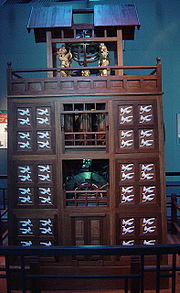
Career as a scholar-official
Su Song was born in modern-day FujianFujian
' , formerly romanised as Fukien or Huguing or Foukien, is a province on the southeast coast of mainland China. Fujian is bordered by Zhejiang to the north, Jiangxi to the west, and Guangdong to the south. Taiwan lies to the east, across the Taiwan Strait...
, near medieval Quanzhou
Quanzhou
Quanzhou is a prefecture-level city in Fujian province, People's Republic of China. It borders all other prefecture-level cities in Fujian but two and faces the Taiwan Strait...
. Like his contemporary Shen Kuo
Shen Kuo
Shen Kuo or Shen Gua , style name Cunzhong and pseudonym Mengqi Weng , was a polymathic Chinese scientist and statesman of the Song Dynasty...
(1031–1095), Su Song was a polymath
Polymath
A polymath is a person whose expertise spans a significant number of different subject areas. In less formal terms, a polymath may simply be someone who is very knowledgeable...
. It was written by his junior colleague and Hanlin
Hanlin Academy
The Hanlin Academy was an academic and administrative institution founded in the eighth century Tang dynasty China by Emperor Xuanzong.Membership in the academy was confined to an elite group of scholars, who performed secretarial and literary tasks for the court. One of its main duties was to...
scholar Ye Mengde
Ye Mengde
Ye Mengde was a Chinese scholar who lived from 1077 to 1148....
(1077–1148) that in Su's youth, he mastered the provincial exams
Imperial examination
The Imperial examination was an examination system in Imperial China designed to select the best administrative officials for the state's bureaucracy. This system had a huge influence on both society and culture in Imperial China and was directly responsible for the creation of a class of...
and rose to the top of the examination list for writing the best essay on general principles and structure of the Chinese calendar
Chinese calendar
The Chinese calendar is a lunisolar calendar, incorporating elements of a lunar calendar with those of a solar calendar. It is not exclusive to China, but followed by many other Asian cultures as well...
. From an early age, his interests in astronomy and calendrical science would lead him onto a distinguished path as a state bureaucrat. In his spare time he was fond of writing poetry, which he used to praise the works of artists such as the painter Li Gonglin
Li Gonglin
Li Gonglin , style name Boshi , pseudonym Longmian Jushi , was a Chinese painter, civil officer and archaeologist in the Northern Song Dynasty....
(1049–1106). He also was an antiquarian and collector of old artworks from previous dynasties.
In matters of administrative government, he had attained the rank of Ambassador and President of the Ministry of Personnel
Three Departments and Six Ministries
The Three Departments and Six Ministries system was the main central administrative system adopted in ancient China. The system first took shape after the Western Han Dynasty , was officially instituted in Sui Dynasty , and matured during Tang Dynasty...
at the capital of Kaifeng, and was known also as an expert in administration and finance. After serving in the Ministry of Personnel, he became a Minister of Justice
Three Departments and Six Ministries
The Three Departments and Six Ministries system was the main central administrative system adopted in ancient China. The system first took shape after the Western Han Dynasty , was officially instituted in Sui Dynasty , and matured during Tang Dynasty...
in 1086. He was appointed as a distinguished editor for the Academy of Scholarly Worthies, where in 1063 he edited, redacted, commented on, and added a preface for the classic work Huainanzi
Huainanzi
The Huáinánzǐ is a 2nd century BCE Chinese philosophical classic from the Han dynasty that blends Daoist, Confucianist, and Legalist concepts, including theories such as Yin-Yang and the Five Phases. It was written under the patronage of Liu An, Prince of Huainan, a legendarily prodigious author...
of the Han Dynasty
Han Dynasty
The Han Dynasty was the second imperial dynasty of China, preceded by the Qin Dynasty and succeeded by the Three Kingdoms . It was founded by the rebel leader Liu Bang, known posthumously as Emperor Gaozu of Han. It was briefly interrupted by the Xin Dynasty of the former regent Wang Mang...
(202 BC–220 AD). Eventually, Su rose to the post of Vice President of the Chancellery
Chancellor of China
The Chancellor , variously translated as Prime Minister, Chancellor of State, Premier or Chief Councillor, was a generic name given to the highest-ranking official in the imperial government in ancient China...
Secretariat. Among many honorable positions and titles conferred upon him, Su Song was also one of the 'Deputy Tutors of the Heir Apparent'. At court, he chose to distance himself from the political rivalries of the Conservatives, led by Prime Minister Sima Guang
Sima Guang
Sīmǎ Guāng was a Chinese historian, scholar, and high chancellor of the Song Dynasty, jinshi 1038.-Life, profession, and works:...
(1019–1086), and the Reformists, led by Prime Minister Wang Anshi
Wang Anshi
Wang Anshi was a Chinese economist, statesman, chancellor and poet of the Song Dynasty who attempted controversial, major socioeconomic reforms...
(1021–1086); although many of his associates were of the Conservative faction. In 1077 he was dispatched on a diplomatic mission to the Liao Dynasty
Liao Dynasty
The Liao Dynasty , also known as the Khitan Empire was an empire in East Asia that ruled over the regions of Manchuria, Mongolia, and parts of northern China proper between 9071125...
of the Khitan people
Khitan people
thumb|250px|Khitans [[Eagle hunting|using eagles to hunt]], painted during the Chinese [[Song Dynasty]].The Khitan people , or Khitai, Kitan, or Kidan, were a nomadic Mongolic people, originally located at Mongolia and Manchuria from the 4th century...
to the north, sharing ideas about calendrical science, as the Liao state had created its own calendar in 994 AD. In an embarrassing event, Su Song admitted to the emperor that the calendar of the Khitan people was in fact a bit more accurate than their own, resulting in the fining and punishment of officials in the Bureau of Astronomy and Calendar. Su was supposed to travel north to Liao and arrive promptly for a birthday celebration and feast on a day which coincided with the winter solstice
Winter solstice
Winter solstice may refer to:* Winter solstice, astronomical event* Winter Solstice , former band* Winter Solstice: North , seasonal songs* Winter Solstice , 2005 American film...
of the Song calendar, but was actually a day behind the Liao calendar. Historian Liu Heping states that Emperor Zhezong of Song
Emperor Zhezong of Song
Emperor Zhezong was the seventh emperor of the Song Dynasty of China. His personal name was Zhao4 Xu1. He reigned from 1085 to 1100....
sponsored Su Song's clocktower in 1086 in order to compete with the Liao for "scientific and national superiority." In 1081, the court instructed Su Song to compile into a book the diplomatic history of Song-Liao relations, an elaborate task that, once complete, filled 200 volumes. With his extensive knowledge of cartography
Cartography
Cartography is the study and practice of making maps. Combining science, aesthetics, and technique, cartography builds on the premise that reality can be modeled in ways that communicate spatial information effectively.The fundamental problems of traditional cartography are to:*Set the map's...
, Su Song was able to settle a heated border dispute between the Song and Liao dynasties.
Astronomy

Lunar mansion
A lunar mansion is a segment of the ecliptic through which the moon moves in its orbit around the earth, often used by ancient cultures as part of their calendar system...
s) forming the astronomical meridians
Meridian (astronomy)
This article is about the astronomical concept. For other uses of the word, see Meridian.In the sky, a meridian is an imaginary great circle on the celestial sphere. It passes through the north point on the horizon, through the celestial pole, up to the zenith, through the south point on the...
, with stars marked in an equidistant cylindrical projection on each side of the equator
Equator
An equator is the intersection of a sphere's surface with the plane perpendicular to the sphere's axis of rotation and containing the sphere's center of mass....
, and thus, was in accordance to their north polar distances. Furthermore, Su Song must have taken advantage of the astronomical findings of his political rival and contemporary astronomer Shen Kuo. This is so because Su Song's fourth star map places the position of the pole star
Pole star
The term "Pole Star" usually refers to Polaris, which is the current northern pole star, also known as the North Star.In general, however, a pole star is a visible star, especially a prominent one, that is approximately aligned with the Earth's axis of rotation; that is, a star whose apparent...
halfway between Tian shu (−350 degrees) and the current Polaris
Polaris
Polaris |Alpha]] Ursae Minoris, commonly North Star or Pole Star, also Lodestar) is the brightest star in the constellation Ursa Minor. It is very close to the north celestial pole, making it the current northern pole star....
; this was the more accurate calculation (by 3 degrees) that Shen Kuo had made when he observed the pole star over a period of three months with his width-improved sighting tube. There were many star maps written before Song's book, but the greatest significance of these star maps by Su Song is, that they represent the oldest extant star maps in printed
Printing
Printing is a process for reproducing text and image, typically with ink on paper using a printing press. It is often carried out as a large-scale industrial process, and is an essential part of publishing and transaction printing....
form.
Pharmacology, botany, zoology, and mineralogy

Botany
Botany, plant science, or plant biology is a branch of biology that involves the scientific study of plant life. Traditionally, botany also included the study of fungi, algae and viruses...
, zoology
Zoology
Zoology |zoölogy]]), is the branch of biology that relates to the animal kingdom, including the structure, embryology, evolution, classification, habits, and distribution of all animals, both living and extinct...
, and mineralogy
Mineralogy
Mineralogy is the study of chemistry, crystal structure, and physical properties of minerals. Specific studies within mineralogy include the processes of mineral origin and formation, classification of minerals, their geographical distribution, as well as their utilization.-History:Early writing...
. In compiling information for pharmaceutical knowledge, Su Song worked with such notable scholars as Zhang Yuxi, Lin Yi, Zhang Dong, and many others. This treatise documented a wide range of pharmaceutical practices, including the use of ephedrine
Ephedrine
Ephedrine is a sympathomimetic amine commonly used as a stimulant, appetite suppressant, concentration aid, decongestant, and to treat hypotension associated with anaesthesia....
as a drug. It includes valuable information on metallurgy and the steel and iron industries during 11th century China. He created a systematic approach to listing various different minerals and their use in medicinal concoctions, such as all the variously known forms of mica
Mica
The mica group of sheet silicate minerals includes several closely related materials having highly perfect basal cleavage. All are monoclinic, with a tendency towards pseudohexagonal crystals, and are similar in chemical composition...
that could be used to cure ills through digestion
Digestion
Digestion is the mechanical and chemical breakdown of food into smaller components that are more easily absorbed into a blood stream, for instance. Digestion is a form of catabolism: a breakdown of large food molecules to smaller ones....
. He wrote of the subconchoidal fracture of native cinnabar
Cinnabar
Cinnabar or cinnabarite , is the common ore of mercury.-Word origin:The name comes from κινναβαρι , a Greek word most likely applied by Theophrastus to several distinct substances...
, signs of ore
Ore
An ore is a type of rock that contains minerals with important elements including metals. The ores are extracted through mining; these are then refined to extract the valuable element....
beds, and provided description on crystal form. Similar to the ore channels formed by circulation of ground water written of by the later German scientist Georgius Agricola, Su Song made similar statements concerning copper carbonate, as did the earlier Rihua Bencao of 970 with copper sulphate. Su's book was also the first pharmaceutical treatise written in China to describe the flax
Flax
Flax is a member of the genus Linum in the family Linaceae. It is native to the region extending from the eastern Mediterranean to India and was probably first domesticated in the Fertile Crescent...
, Urtica thunbergiana
Urtica thunbergiana
Urtica thunbergiana is a species of the genus Urtica. It is found in Japan, mainland China and Taiwan. The habitat if the species is moist forests in the mountains. It is in flower from July to September, and its seeds ripen from August to October. The larvae of Vanessa indica, a species of...
, and Corchoropsis tomentosa (crenata) plants. According to Edward H. Schafer, Su accurately described the translucent quality of fine realgar
Realgar
Realgar, α-As4S4, is an arsenic sulfide mineral, also known as "ruby sulphur" or "ruby of arsenic". It is a soft, sectile mineral occurring in monoclinic crystals, or in granular, compact, or powdery form, often in association with the related mineral, orpiment . It is orange-red in colour, melts...
, its origin from pods found in rocky river gorges, its matrix being pitted with holes and having a deep red, almost purple color, and that the mineral varied in sizes ranging from the size of a pea to a walnut. Citing evidence from an ancient work by Zheng Xuan
Zheng Xuan
Zheng Xuan , courtesy name Kangcheng , was an influential Chinese commentator and Confucian scholar of the Han Dynasty. He was born in modern Weifang, Shandong, and was a student of Ma Rong.-See also:*Three Kingdoms...
(127–200), Su believed that physicians of the ancient Zhou Dynasty
Zhou Dynasty
The Zhou Dynasty was a Chinese dynasty that followed the Shang Dynasty and preceded the Qin Dynasty. Although the Zhou Dynasty lasted longer than any other dynasty in Chinese history, the actual political and military control of China by the Ji family lasted only until 771 BC, a period known as...
(1046–256 BC) used realgar as a remedy for ulcer
Peptic ulcer
A peptic ulcer, also known as PUD or peptic ulcer disease, is the most common ulcer of an area of the gastrointestinal tract that is usually acidic and thus extremely painful. It is defined as mucosal erosions equal to or greater than 0.5 cm...
s. As believed in Su's day, the "five poisons" used by Zhou era physicians for this purpose were thought to be cinnabar, realgar, chalcanthite
Chalcanthite
Chalcanthite, whose name derives from the Greek, chalkos and anthos, meaning copper flower, is a richly-colored blue/green water-soluble sulfate mineral CuSO4·5H2O. It is commonly found in the late-stage oxidation zones of copper deposits...
, alum
Alum
Alum is both a specific chemical compound and a class of chemical compounds. The specific compound is the hydrated potassium aluminium sulfate with the formula KAl2.12H2O. The wider class of compounds known as alums have the related empirical formula, AB2.12H2O.-Chemical properties:Alums are...
, and magnetite
Magnetite
Magnetite is a ferrimagnetic mineral with chemical formula Fe3O4, one of several iron oxides and a member of the spinel group. The chemical IUPAC name is iron oxide and the common chemical name is ferrous-ferric oxide. The formula for magnetite may also be written as FeO·Fe2O3, which is one part...
. Su made systematic descriptions of animals and the environmental regions they could be found, such as different species of freshwater, marine, and shore crabs. For example, he noted that the freshwater crab species Eriocher sinensis could be found in the Huai River
Huai River
The Huai River is a major river in China. The Huai River is located about mid-way between the Yellow River and Yangtze River, the two largest rivers in China, and like them runs from west to east...
running through Anhui
Anhui
Anhui is a province in the People's Republic of China. Located in eastern China across the basins of the Yangtze River and the Huai River, it borders Jiangsu to the east, Zhejiang to the southeast, Jiangxi to the south, Hubei to the southwest, Henan to the northwest, and Shandong for a tiny...
, in waterways near the capital city, as well as reservoirs and marshes of Hebei
Hebei
' is a province of the People's Republic of China in the North China region. Its one-character abbreviation is "" , named after Ji Province, a Han Dynasty province that included what is now southern Hebei...
. Su's book was preserved and copied into the Bencao Gangmu of the Ming Dynasty
Ming Dynasty
The Ming Dynasty, also Empire of the Great Ming, was the ruling dynasty of China from 1368 to 1644, following the collapse of the Mongol-led Yuan Dynasty. The Ming, "one of the greatest eras of orderly government and social stability in human history", was the last dynasty in China ruled by ethnic...
(1368–1644) physician and pharmacologist Li Shizhen
Li Shizhen
Li Shizhen , courtesy name Dongbi , was one of the greatest Chinese herbologists and acupuncturists in Chinese history. His major contribution to medicine was his 27-year work, which is found in his epic book the Bencao Gangmu...
(1518–1593).
Horology and mechanical engineering
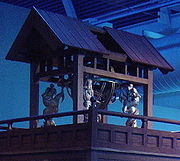
Middle Ages
The Middle Ages is a periodization of European history from the 5th century to the 15th century. The Middle Ages follows the fall of the Western Roman Empire in 476 and precedes the Early Modern Era. It is the middle period of a three-period division of Western history: Classic, Medieval and Modern...
, surrounding himself with an entourage of notable engineers and astronomers to assist in various projects. Xinyi Xiangfayao (lit. "Essentials of a New Method for Mechanizing the Rotation of an Armillary Sphere and a Celestial Globe"), written in 1092, was the final product of his life's achievements in horology and clockwork. Fortunately, this book of Su's that was handed down included 47 different illustrations of great detail of the mechanical workings for his astronomical
Astronomical clock
An astronomical clock is a clock with special mechanisms and dials to display astronomical information, such as the relative positions of the sun, moon, zodiacal constellations, and sometimes major planets.-Definition:...
clocktower.
Su Song's greatest project was the 40-foot-tall water-powered astronomical clocktower constructed in Kaifeng, the wooden pilot model completed in 1088, the bronze components cast by 1090, while the wholly finished work was completed by 1094 during the reign of Emperor Zhezong of Song
Emperor Zhezong of Song
Emperor Zhezong was the seventh emperor of the Song Dynasty of China. His personal name was Zhao4 Xu1. He reigned from 1085 to 1100....
. The emperor had previously commissioned Han Gonglian, Acting Secretary of the Ministry of Personnel, to head the project, but the leadership position was instead handed down to Su Song. The emperor ordered in 1086 for Su to reconstruct the hun yi, or "armillary clock", for a new clock-tower in the capital city. Su worked with the aid of Han Gong-lian, who applied his extensive knowledge of mathematics to the construction of the clock-tower. A small-scale wooden model was first crafted by Su Song, testing its intricate parts before applying it to an actual full-scale clock tower. In the end, the clock-tower had many impressive features, such as the water-powered, rotating armillary sphere crowning the top-level and weighing some 10 to 20 tons, a bronze celestial globe located in the middle that was 4.5 feet in diameter, mechanically-timed and rotating manikin
Manikin
A manikin is a life-sized anatomical human model used in education. The most famous of these, the Transparent Anatomical Manikin is a three-dimensional, transparent model of a human being, created for medical instructional purposes. The first TAM was created by designer Richard Rush in 1968...
s dressed in miniature Chinese clothes
Han Chinese clothing
Hanfu or Han Chinese Clothing, also sometimes known as Hanzhuang , Huafu , and sometimes referred in English sources simply as Silk Robe or Chinese Silk Robe refers to the historical dress of the Han Chinese people, which was worn for millennia before the conquest by the Manchus and the...
that would exit miniature opening doors to announce the time of day by presenting designated reading plaques, ringing bells and gongs, or beating drums, a sophisticated use of oblique gears and an escapement mechanism, as well as an exterior facade of a fanciful Chinese pagoda
Chinese pagoda
Chinese Pagodas are a traditional part of Chinese architecture. In addition to religious use, since ancient times Chinese pagodas have been praised for the spectacular views which they offer, and many famous poems in Chinese history attest to the joy of scaling pagodas.-History:The pagoda is...
. Upon its completion, the tower was called the Shui Yun Yi Xiang Tai, or "Tower for the Water-Powered Sphere and Globe". Joseph Needham writes:
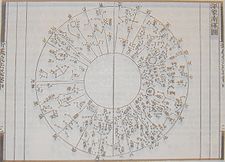
Jurchens
The Jurchens were a Tungusic people who inhabited the region of Manchuria until the 17th century, when they adopted the name Manchu...
of the Manchuria
Manchuria
Manchuria is a historical name given to a large geographic region in northeast Asia. Depending on the definition of its extent, Manchuria usually falls entirely within the People's Republic of China, or is sometimes divided between China and Russia. The region is commonly referred to as Northeast...
-based Jin Dynasty
Jin Dynasty, 1115–1234
The Jīn Dynasty ; Khitan language: Nik, Niku; ; 1115–1234), also known as the Jurchen Dynasty, was founded by the Wanyan clan of the Jurchens, the ancestors of the Manchus who established the Qing Dynasty some 500 years later...
. The clock-tower was dismantled piece by piece by the Jurchens, who carted its components back to their own capital in modern-day Beijing. However, due to the complexity of the tower, they were unable to successfully piece it back together. The new Emperor Gaozong of Song
Emperor Gaozong of Song
Emperor Gaozong , born Zhao Gou, was the tenth emperor of the Song Dynasty of China, and the first emperor of the Southern Song. He reigned from 1127 to 1162. He fled south after the Jurchens overran Kaifeng in the Jingkang Incident, hence the beginning of the Southern Song dynasty 1127–1279...
instructed Su's son, Su Xie, to construct a new astronomical clock-tower in its place, and Su Xie set to work studying his father's texts with a team of other experts. However, they were also unsuccessful in creating another clock tower, and Su Xie was convinced that Su Song had purposefully left out essential components in his written work and diagrams so that others would not steal his ideas.
As the sinologist historian Derk Bodde
Derk Bodde
Derk Bodde was a prominent 20th century American Sinologist and historian of China. He authored pioneering work in the history of the Chinese legal system....
points out, Su Song's astronomical clock did not lead to a new generation of mass-produced clockworks throughout China since his work was largely a government-sponsored endeavor for the use of astronomers and astrologer
Astrologer
An astrologer practices one or more forms of astrology. Typically an astrologer draws a horoscope for the time of an event, such as a person's birth, and interprets celestial points and their placements at the time of the event to better understand someone, determine the auspiciousness of an...
s in the imperial court. Yet the mechanical legacy of Su Song did not end with his work. In about 1150, the writer Xue Jixuan noted that there were four types of clocks in his day, the basic waterclock, the incense clock
Incense clock
The incense clock is a Chinese timekeeping device that appeared during the Song Dynasty and spread to neighboring countries such as Japan. The clocks' bodies are effectively specialized censers that hold incense sticks or powdered incense that have been manufactured and calibrated to a known rate...
, the sundial
Sundial
A sundial is a device that measures time by the position of the Sun. In common designs such as the horizontal sundial, the sun casts a shadow from its style onto a surface marked with lines indicating the hours of the day. The style is the time-telling edge of the gnomon, often a thin rod or a...
, and the clock with 'revolving and snapping springs' ('gun tan'). The rulers of the continuing Yuan Dynasty
Yuan Dynasty
The Yuan Dynasty , or Great Yuan Empire was a ruling dynasty founded by the Mongol leader Kublai Khan, who ruled most of present-day China, all of modern Mongolia and its surrounding areas, lasting officially from 1271 to 1368. It is considered both as a division of the Mongol Empire and as an...
(1279–1368 AD) had a vested interest in the advancement of mechanical clockworks. The astronomer Guo Shoujing
Guo Shoujing
Guo Shoujing , courtesy name Ruosi , was a Chinese astronomer, engineer, and mathematician born in Xingtai, Hebei who lived during the Yuan Dynasty...
helped restore the Beijing Ancient Observatory
Beijing Ancient Observatory
The Beijing Ancient Observatory is a pretelescopic observatory located in Beijing, China. The revolutionary tools used within this ancient observatory were built in 1442 during the Ming Dynasty, and later amended during the Qing....
beginning in 1276, where he crafted a water-powered armillary sphere and clock with clock jacks being fully implemented and sounding the hours. Complex gearing for uniquely Chinese clockworks were continued in the Ming Dynasty
Ming Dynasty
The Ming Dynasty, also Empire of the Great Ming, was the ruling dynasty of China from 1368 to 1644, following the collapse of the Mongol-led Yuan Dynasty. The Ming, "one of the greatest eras of orderly government and social stability in human history", was the last dynasty in China ruled by ethnic...
(1368–1644), with new designs driven by the power of falling sand instead of water to provide motive power to the wheel drive, and some Ming clocks perhaps featured reduction gearing rather than the earlier escapement of Su Song. The earliest such design of a sand-clock was made by Zhan Xiyuan around 1370, which featured not only the scoop wheel of Su Song' device, but also a new addition of a stationary dial face
Dial (measurement)
A dial is generally a flat surface, circular or rectangular, with numbers or similar markings on it, used for displaying the setting or output of a timepiece, radio, clock, watch, or measuring instrument...
over which a pointer circulated, much like new European clocks of the same period.
Su Song's escapement mechanism

In his writing, Su Song credited, as the predecessor of his working clock, the hydraulic-powered armillary sphere of Zhang Heng
Zhang Heng
Zhang Heng was a Chinese astronomer, mathematician, inventor, geographer, cartographer, artist, poet, statesman, and literary scholar from Nanyang, Henan. He lived during the Eastern Han Dynasty of China. He was educated in the capital cities of Luoyang and Chang'an, and began his career as a...
(78–139 AD), an earlier Chinese scientist. Su Song was also strongly influenced by the earlier armillary sphere created by Zhang Sixun
Zhang Sixun
Zhang Sixun was a Chinese astronomer and military engineer from Bazhong, Sichuan during the early Song Dynasty . He is credited with creating an armillary sphere for his astronomical clock tower that employed the use of liquid mercury...
(976 AD), who also employed the escapement mechanism and used liquid mercury
Mercury (element)
Mercury is a chemical element with the symbol Hg and atomic number 80. It is also known as quicksilver or hydrargyrum...
instead of water in the waterwheel of his astronomical clock tower (since liquid mercury would not freeze during winter and would not corrode and rust metal components over time). However, Su Song stated in his writing that after Zhang's death, no one was able to replicate his device, much like his own.
The mechanical clockworks for Su Song's astronomical tower featured a great driving-wheel that was 11 feet in diameter, carrying 36 scoops on its circumference, into each of which water would pour at uniform rate from the 'constant-level tank' (Needham, Fig. 653). The main driving shaft of iron, with its cylindrical necks supported on iron crescent-shaped bearings, ended in a pinion which engages with a gear-wheel at the lower end of the main vertical transmission-shaft.
Joseph Needham gives a general description of the clock-tower itself:
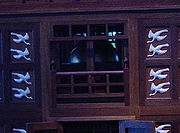
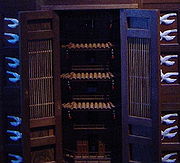
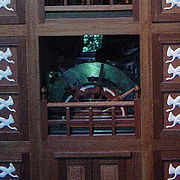
Noria
A noria is a machine for lifting water into a small aqueduct, either for the purpose of irrigation or, in at least one known instance, to feed seawater into a saltern....
s with their tanks and the manual wheel for operating them.
Fig. 657 displays a rather miniature and scaled-down pic for the basics of the escapement mechanism in an illustration (from Su's book), with Needham's caption here in this quote: "The 'celestial balance' or escapement mechanism of Su Sung's clockwork (Xinyi Xiangfayao, ch. 3, p. 18b),". The latter figure carefully labels:
- a right upper lock
- upper link
- left upper lock
- axle or pivot
- long chain
- upper counterweight
- sump
- checking fork of the lower balancing lever
- coupling tongue
- main (i.e. lower) counterweight.
Figure 658. displays a more intricate and most-telling half-page scale drawing of Su Song's large escapement mechanism, labeling these individual parts as they interact with one another:
- arrested spoke
- left upper lock
- scoop being filled by
- water jet from constant-level tank
- small counterweight
- checking fork tripped by a projection pin on the scoop, and forming the near end of
- the lower balancing lever with
- its lower counterweight
- coupling tongue, connected by
- the long chain with
- the upper balancing lever, which has at its far end
- the upper counterweight, and at its near end
- a short length chain connecting it with the upper lock beneath it;
- right upper lock
The endless chain drive
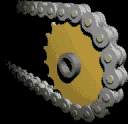
History of Greece
The history of Greece encompasses the history of the territory of the modern state of Greece, as well as that of the Greek people and the areas they ruled historically. The scope of Greek habitation and rule has varied much through the ages, and, as a result, the history of Greece is similarly...
Philo of Byzantium
Philo of Byzantium
Philo of Byzantium , also known as Philo Mechanicus, was a Greek engineer and writer on mechanics, who lived during the latter half of the 3rd century BC...
(3rd century BC) featured a sort of endless belt for his magazine arcuballista
Ballista
The ballista , plural ballistae, was an ancient missile weapon which launched a large projectile at a distant target....
, which did not transmit continuous power, the influential source for Su Song's chain drive is most likely the continuously-driven chain pump known in China since the Han Dynasty
Han Dynasty
The Han Dynasty was the second imperial dynasty of China, preceded by the Qin Dynasty and succeeded by the Three Kingdoms . It was founded by the rebel leader Liu Bang, known posthumously as Emperor Gaozu of Han. It was briefly interrupted by the Xin Dynasty of the former regent Wang Mang...
(202 BC–220 AD). From his horological treatise, Su Song states:
In addition, the motion gear rings and the upper drive wheel both had 600 teeth, which by Su's mathematical precision carefully calculated measured units of the day in a division of 1/600. These gears having 600 teeth would thus ensure the division the day into basic unit measurements of 2 minutes and 24 seconds.
Su Song's armillary sphere
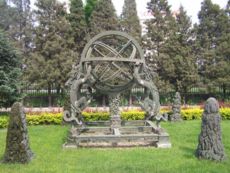
Alfonso X of Castile
Alfonso X was a Castilian monarch who ruled as the King of Castile, León and Galicia from 1252 until his death...
in Islamic-era Spain. The chief difference was that Alfonso's instrument featured an arrangement for making measurements of the azimuth and altitude, which was present in the Arabic tradition, while Su Song's armillary sphere was duly graduated. For the drawing of Su's armillary sphere, the listing of components are:
- The Outer Nest
- meridian circle
- horizon circle
- outer equator circle
- The Middle Nest
- solstitial colure circle
- ecliptic circle
- diurnal motion gear-ring, connecting with the power-drive
- The Inner Nest
- polar-mounted declination ring or hour-angle circle, with
- sighting tube attached to it and strengthened by a
- diametral brace
- Other Parts
- vertical column concealing the transmission shaft
- supporting columns in the form of dragons
- cross-piece of the base, incorporating water-levels
- south polar pivot
- north polar pivit
Transmission of Su's text and his legacy
When Su Song's Xinyi Xiangfayao was written in 1092 and the horological monograph finalized and presented in 1094, his work was published and widely printedPrinting
Printing is a process for reproducing text and image, typically with ink on paper using a printing press. It is often carried out as a large-scale industrial process, and is an essential part of publishing and transaction printing....
in the north (see woodblock printing
Woodblock printing
Woodblock printing is a technique for printing text, images or patterns used widely throughout East Asia and originating in China in antiquity as a method of printing on textiles and later paper....
and movable type
Movable type
Movable type is the system of printing and typography that uses movable components to reproduce the elements of a document ....
of Bi Sheng
Bi Sheng
Bì Shēng was the inventor of the first known movable type technology. Bi Sheng's system was made of Chinese porcelain and was invented between 1041 and 1048 in China.-Movable type printing:...
). In the south, printing and circulation of his work was not widely distributed until Shi Yuanzhi of Jiangsu
Jiangsu
' is a province of the People's Republic of China, located along the east coast of the country. The name comes from jiang, short for the city of Jiangning , and su, for the city of Suzhou. The abbreviation for this province is "苏" , the second character of its name...
had it printed there in 1172.
When presenting his clocktower design to the Emperor Zhezong, Su Song equated the constant flow of water with the continuous movements of the heavens, the latter of which symbolized the unceasing power of the emperor. This appealed to emperor, who featured artwork representing the clocktower on vehicles of major imperial processions, as illustrated in the Illustration of the Imperial Grand Carriage Procession of 1053.
The later Ming Dynasty
Ming Dynasty
The Ming Dynasty, also Empire of the Great Ming, was the ruling dynasty of China from 1368 to 1644, following the collapse of the Mongol-led Yuan Dynasty. The Ming, "one of the greatest eras of orderly government and social stability in human history", was the last dynasty in China ruled by ethnic...
/Qing Dynasty
Qing Dynasty
The Qing Dynasty was the last dynasty of China, ruling from 1644 to 1912 with a brief, abortive restoration in 1917. It was preceded by the Ming Dynasty and followed by the Republic of China....
scholar Qian Zeng (1629–1699) held an old volume of Su's work, which he faithfully reproduced in a newly-printed edition. He took special care in avoiding any rewording or inconsistencies with the original text as well. Again, it was later reprinted by Zhang Xizu (1799–1844).
Interestingly enough, Su Song's treatise on astronomical clockwork was not the only one made in China during his day, as the Song Shi (compiled in 1345) records the written treatise of the Shuiyunhun Tianjiyao (Wade-Giles: Shui Yun Hun Thien Chi Yao; lit. Essentials of the [Technique of] making Astronomical Apparatus revolve by Water-Power), written by Juan Taifa. However, this treatise no longer survives.
In the realm of modern research, the late British biochemist
Biochemist
Biochemists are scientists who are trained in biochemistry. Typical biochemists study chemical processes and chemical transformations in living organisms. The prefix of "bio" in "biochemist" can be understood as a fusion of "biological chemist."-Role:...
and historian of Chinese science Joseph Needham
Joseph Needham
Noel Joseph Terence Montgomery Needham, CH, FRS, FBA , also known as Li Yuese , was a British scientist, historian and sinologist known for his scientific research and writing on the history of Chinese science. He was elected a fellow of the Royal Society in 1941, and as a fellow of the British...
(1900–1995) (known as Li Yuese in China) did extensive research and analysis of Su Song's texts and various achievements in his Science and Civilization in China book series. Joseph Needham also related many detailed passages from Su's contemporary medieval Chinese sources on the life of Su and his achievements known in his day. In 1956, John Christiansen reconstructed a model of Su Song's clocktower in a famous drawing, which garnered attention in the West towards 11th century Chinese engineering. A miniature model of Su Song's clock was reconstructed by John Cambridge and is now on display at the National Science Museum
Science Museum (London)
The Science Museum is one of the three major museums on Exhibition Road, South Kensington, London in the Royal Borough of Kensington and Chelsea. It is part of the National Museum of Science and Industry. The museum is a major London tourist attraction....
at South Kensington
South Kensington
South Kensington is a district in the Royal Borough of Kensington and Chelsea in London. It is a built-up area located 2.4 miles west south-west of Charing Cross....
, London. In China, the clocktower was reconstructed to one-fifth its actual scale by Wang Zhenduo, who worked for the Chinese Historical Museum in Beijing in the 1950s.
See also
- List of Chinese writers
- List of mineralogists
- List of cartographers
- Clock towerClock towerA clock tower is a tower specifically built with one or more clock faces. Clock towers can be either freestanding or part of a church or municipal building such as a town hall. Some clock towers are not true clock towers having had their clock faces added to an already existing building...
- Water clockWater clockA water clock or clepsydra is any timepiece in which time is measured by the regulated flow of liquid into or out from a vessel where the amount is then measured.Water clocks, along with sundials, are likely to be the oldest time-measuring instruments, with the only exceptions...
- Pin-pallet escapement
- Grasshopper escapementGrasshopper escapementThe grasshopper escapement is an unusual, low-friction escapement for pendulum clocks invented by British clockmaker John Harrison around 1722. An escapement, part of every mechanical clock, is the mechanism that causes the clock's gears to move forward by a fixed distance at regular intervals and...
- Technology of the Song DynastyTechnology of the Song DynastyThe Song Dynasty provided some of the most significant technological advances in Chinese history, many of which came from talented statesmen drafted by the government through imperial examinations....
- Richard of WallingfordRichard of WallingfordRichard of Wallingford was an English mathematician who made major contributions to astronomy/astrology and horology while serving as abbot of St Albans Abbey in Hertfordshire.-Biography:...
- Villard de HonnecourtVillard de HonnecourtVillard de Honnecourt was a 13th-century artist from Picardy in northern France. He is known to history only through a surviving portfolio of 33 sheets of parchment containing about 250 drawings dating from the 1220s/1240s, now in the Bibliothèque Nationale, Paris...
- Giovanni de Dondi
- John HarrisonJohn HarrisonJohn Harrison was a self-educated English clockmaker. He invented the marine chronometer, a long-sought device in solving the problem of establishing the East-West position or longitude of a ship at sea, thus revolutionising and extending the possibility of safe long distance sea travel in the Age...
- Thomas TompionThomas TompionThomas Tompion was an English clock maker, watchmaker and mechanician who is still regarded to this day as the Father of English Clockmaking. Tompion's work includes some of the most historic and important clocks and watches in the world and can command very high prices whenever outstanding...
- George GrahamGeorge Graham (clockmaker)George Graham was an English clockmaker, inventor, and geophysicist, and a Fellow of the Royal Society.He was born to George Graham in Kirklinton, Cumberland. A Friend like his mentor Thomas Tompion, Graham left Cumberland in 1688 for London to work with Tompion...
- Jean FroissartJean FroissartJean Froissart , often referred to in English as John Froissart, was one of the most important chroniclers of medieval France. For centuries, Froissart's Chronicles have been recognized as the chief expression of the chivalric revival of the 14th century Kingdom of England and France...
- Dante AlighieriDante AlighieriDurante degli Alighieri, mononymously referred to as Dante , was an Italian poet, prose writer, literary theorist, moral philosopher, and political thinker. He is best known for the monumental epic poem La commedia, later named La divina commedia ...
- Zhang HengZhang HengZhang Heng was a Chinese astronomer, mathematician, inventor, geographer, cartographer, artist, poet, statesman, and literary scholar from Nanyang, Henan. He lived during the Eastern Han Dynasty of China. He was educated in the capital cities of Luoyang and Chang'an, and began his career as a...

